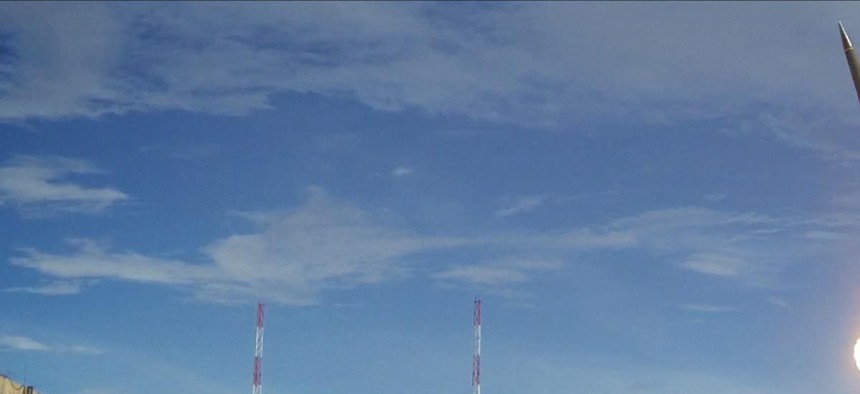
The first of two THAAD interceptors is launched by the Missile Defense Agency. Missile Defense Agency
The US Missile System Driving a Wedge Between China, South Korea
The tentative decision to install a new missile interceptor system in South Korea could force Seoul to pick between its Washington ally and its Beijing neighbor.
South Korea faces a great challenge, and it has a great opportunity. Its handling of a relatively obscure issue will provide great insight into its future in a vital and volatile area.
In the coming months, South Korea and the United States will discuss the potential deployment of the Terminal High-Altitude Area Defense system (a.k.a. THAAD). This system detects incoming missiles and intercepts them at long ranges and high altitudes by using its own hit-to-kill missiles. Think of it as the outer layer in a multi-layered defense system designed to protect South Korea—and the 28,500 U.S. military personnel stationed there—from North Korean missile attacks.
The existing defense in South Korea is a system that integrates Aegis and Patriot systems operated by both countries. While capable, this system lacks the outer layer provided by THAAD, leaving large holes in coverage. If conflict were to occur, military commanders would be forced to prioritize which areas of South Korea to defend. Given this situation, it is easy to see why General Curtis Scaparrotti, the top U.S. commander in Korea, has recommended the deployment of THAAD to his superiors. From the military perspective, it is a prudent step to make the peninsula’s defensive system as complete as possible given the unpredictability of North Korea under Kim Jong-un.
This is where it gets interesting. China does not want to see THAAD deployed to South Korea. The Chinese perceive the system as a threat to their military strategy, and to some degree they are correct. China considers the continued presence of U.S. forces in the Asia/Pacific as contradictory to their national interest. This includes forces stationed at bases in South Korea, Japan, and Guam. The Chinese are cunning competitors, and they have developed a sound strategy for countering U.S. influence by building an arsenal of guided missiles to overwhelm U.S. defenses and hit warships, airplanes, and bases with great accuracy. This imposes high cost on the United States during any potential conflict with China, because defending against these attacks is technologically difficult and very expensive. The Chinese strategy is commonly called anti-access/area-denial (A2/AD) because it makes it nearly impossible to deploy forces to bases or waters close to China or to operate once they are there.
Any system that could counter this strategy is perceived as a threat by the Chinese. THAAD is such a system. If any force were to launch missiles against South Korea, THAAD could intercept them. Moreover, THAAD is capable of being fully integrated into the South Korean defenses, and the more integrated the layers, the more capable the overall system would be against any missile threat. The truth is that the presence of THAAD would make it difficult for the Chinese to fully implement their A2/AD strategy, resulting in decreased leverage as they pursue preeminence in the region.
To prevent the deployment of THAAD, China has begun to put diplomatic pressure on South Korea, even before the United States has formally requested THAAD (which is expected to happen sometime this spring or summer). China has a great deal of leverage—both diplomatic and economic—that it can apply. China is South Korea’s #1 trading partner, and the two are negotiating an important free trade agreement. Additionally, South Korea’s President Park Geun-hye knows that she needs Chinese cooperation to pursue a top priority of her Administration, which is preparing for reunification with North Korea.
In short, the THAAD issue places South Korea squarely between its top trading partner and its only security ally in what appears to be a zero-sum decision. Whichever direction it goes, South Korea must find a way say “no” without causing undue damage to a critical relationship.
During my service in South Korea, I learned a popular saying: “A shrimp breaks its back in a fight between whales.” The Korean people have long viewed themselves as the shrimp…the weaker power situated between China and Japan.
Today, the situation is different. South Korea is a great nation with a strong military and vibrant economy. It also possesses tremendous soft power as a global leader in technology, sports, culture, fashion, and the arts. In 2018, it will host its second Olympic Games. If it decides to, Korea can play a major role as a bridge between East and West, a conduit between Confucianism and capitalism, and an example of a traditional society that is enhanced through modernity, not threatened by it.
This is why it will be fascinating to see how South Korea handles THAAD. This diplomatic conundrum comes at a unique moment it its history, when it is primed for a leading role on the world stage. The result will foreshadow its approach to even bigger issues affecting East Asia and beyond.
This post appears courtesy of CFR.org.



